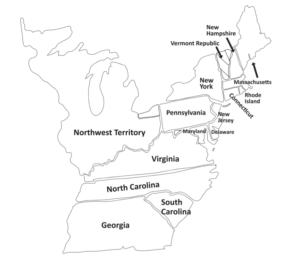Handout H: Map—Emancipation in the Early Republic
Handout H: Map—Emancipation in the Early Republic
Directions: Use the table provided to complete the map. In each state or territory, write the date of a law providing for gradual emancipation in that state. Next, use map pencils or markers to color code the map.
- Yellow: abolished slavery outright
- Green: gradual emancipation
- Blue: abolished slavery with the 13th Amendment in 1865

Directions: Slavery was legal in all 13 colonies at the time of the Declaration of Independence in 1776. Use the table below to complete the map provided in order to show steps toward abolition of slavery. Prepare to discuss your observations and comparisons as your teacher directs.
Notes: For further reading, consult Douglas Harper, http://slavenorth.com
(Year of a law providing for emancipation, state, year when the last remaining slaves either died or won their freedom, notes)
|
Year of a law providing for emancipation |
State |
Year when the last remaining slaves either died or won their freedom |
Notes |
|
1777 |
Republic of Vermont |
1777 |
Vermont Republic’s 1777 constitution abolished slavery outright. Vermont became the 14th state admitted to the Union in 1791. |
|
1780 |
Pennsylvania |
1840s or 1850s |
According to Pennsylvania’s gradual emancipation law of 1780, all children born in Pennsylvania were free persons. Children born to slaves were required to work for their mothers’ master until age 28. Enslaved individuals living in Pennsylvania before 1780 remained enslaved for life. |
|
1783 |
Massachusetts (including Maine) |
1783 |
A 1783 judicial decision outlawed slavery, based on the Massachusetts 1780 constitution. |
|
1783 |
New Hampshire |
1857 |
New Hampshire’s 1783 constitution, stating “all men are born equal and independent” was widely understood as a rejection of slavery. A law in 1857 stating, “No person because of descent, should be disqualified from becoming a citizen” prohibited slavery. |
|
1784 |
Connecticut |
1848 |
A law in 1784 provided that any child of slaves born after March 1 would become free at age 25; a 1797 law reduced that age to 21. Another law in 1848 abolished slavery. |
|
1784 |
Rhode Island |
1840s |
All children of slaves born after March 1 were considered “apprentices.” Girls would become free at age 18, boys at age 21. The 1784 law did not infringe on the right of Rhode Island ship-owners to participate in the slave trade. |
|
1787 |
Northwest Territory |
1787 |
Article 6 of the Northwest Ordinance provided: “ There shall be neither slavery nor involuntary servitude in the said territory, otherwise than in the punishment of crimes whereof the party shall have been duly convicted: Provided, always, That any person escaping into the same, from whom labor or service is lawfully claimed in any one of the original States, such fugitive may be lawfully reclaimed and conveyed to the person claiming his or her labor or service as aforesaid.” |
|
1799 |
New York |
1827 |
A law in 1799 provided that all children of slaves born after July 4 would be free—girls at age 25 and boys at age 28, but until then they remained property of the mother’s master. Enslaved individuals living in New York before 1799 remained enslaved for life. |
|
1804 |
New Jersey |
1846 |
A law in 1804 provided that all children of slaves born after July 4 would be free—girls at age 21 and boys at age 25, but until then they remained property of the mother’s master. Enslaved individuals living in New York before 1799 remained enslaved for life. An 1846 law abolished slavery permanently. |
|
1865 |
Delaware |
13th Amendment to the U.S. Constitution: “Neither slavery nor involuntary servitude, except as a punishment for crime whereof the party shall have been duly convicted, shall exist within the United States, or any place subject to their jurisdiction.” |
|
|
1865 |
Georgia |
13th Amendment |
|
|
1865 |
Maryland |
13th Amendment |
|
|
1865 |
North Carolina |
13th Amendment |
|
|
1865 |
South Carolina |
13th Amendment |
|
|
1865 |
Virginia |
13th Amendment |
